Reserve Bank of Australia Annual Report – 1965 Monetary Policy
The primary task of the Bank's monetary policy in 1964/65 was to support other aspects of economic policy in restraining the growth of expenditure while not discouraging production or productivity growth. A wide range of measures was used to this end, including action on trading bank liquidity, directions to the trading banks on lending policy, consultations with the savings banks and discussions with other groups of lenders, action to bring about higher interest rates and security yields, and open market operations. As to the effect of these policies, we cannot do more than observe that in 1964/65 serious boom conditions did not develop and asset values did not rise to any extent.
Monetary policy operates mainly through influencing the cost and availability of funds and willingness to forego or postpone expenditure plans. Although the great bulk of expenditure is financed from income or from the accumulated funds (mainly bank deposits or other financial assets) of those undertaking it, even this part can be affected by interest rates and the ease with which financial assets can be realised.
Changes in interest rates and other monetary conditions also affect the re-arrangement of financial assets, which at times has been an important factor in making additional funds available to spenders. In conditions of excessive expenditures it is particularly important to the monetary authorities to discourage large-scale transfers of funds to financial intermediaries not subject to liquidity and other restraints.
Monetary policy necessarily works to a substantial degree through the banking system. At June, 1964 bank liquidity was comfortable. Little change was expected in absolute terms in 1964/65 but this would mean a fall over the year in liquidity ratios as deposits were expected to increase. Any increase in the Statutory Reserve Deposit ratio might therefore have to be reversed as the year progressed.
Interest rates were already at quite high levels and the banks were exercising restraint in their new lending. In these circumstances the Bank sought, with moderate success, to absorb funds by open market operations. At the same time, in discussions with the banks, the need to keep down new lending was stressed. In the distribution of their lending they were asked to lean strongly towards support of expenditure which would aid production rather than add to consumption, and to avoid lending for possibly speculative purposes. Similarly in consultations with the savings banks the need to gear their lending for housing to the expected long term growth in their deposits, rather than to short run movements, was emphasised.
Facilities for fixed deposits with trading banks were extended in September. In October, when liquidity was rising strongly, the Statutory Reserve Deposit ratio was raised 1 per cent.
In March there was a general increase in trading bank interest rates, on both deposits and advances, followed by an increase in savings bank rates. Security yields and rates offered in the market also rose. Interest rates generally are now higher than at any time since the early 1930's; this largely reflects the heavy demands on the capital market and the strong competition for funds.
The effectiveness of the increase in interest rates was reinforced by the strong seasonal run-down in liquidity. In the first instance the effects of the run-down were felt by the banks and a relatively small proportion of their customers, but it soon spread more widely.
The banks had to meet most of the liquidity drain in the June quarter from resources in their own hands, selling a large part of their Government security holdings. Only a small amount of relief was provided by reductions, for liquidity purposes, of 1.6 per cent in the Statutory Reserve Deposit ratio.
On the lending side, policy was particularly directed at the rate of new lending commitments. New lending has the greatest significance in relation to expenditure decisions, and restraint on such commitments provides the most effective method for trading banks to control the expansion of their advances. Once a limit has been established it is much more difficult for a bank to take restrictive action. In 1964/65 the rate of new approvals was kept to about the same level as in the previous two years. Allowing for the general expansion of the economy and the particularly heavy demands on banks in the last quarter, there is little doubt that they exercised considerable restraint in their lending.
Bank Interest Rates
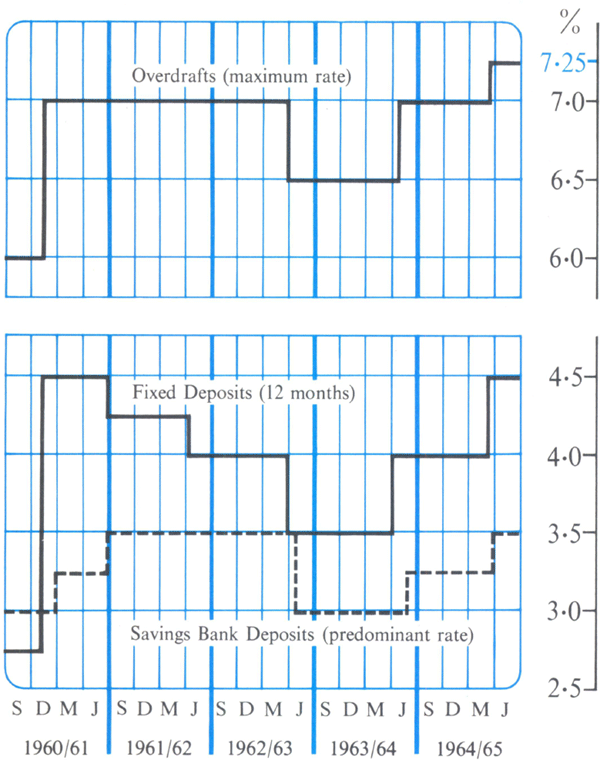
Because part of the demand for advances can be satisfied from existing limits, banks were also asked to keep existing limits under review and maintain a high rate of reductions and cancellations. In the event, the rise in total limits was the smallest for several years.
It was to be expected, in view of the tightening in the financial position of the private sector, that the increase in outstanding advances over the year would be substantial. In the light of events, particularly the severe liquidity drain in the final quarter, the increase over the year in aggregate advances could be regarded as consistent with policy.
In these ways the Bank sought to restrict the availability of credit to bank borrowers. At the same time it sought to limit the growth of lending by other financial institutions, over which it has no direct control, by ensuring that interest rates on financial assets under its influence (especially fixed deposits) were competitive with general market rates, thereby making funds less readily available and more costly to financial institutions borrowing in the market.
The outstandings of some non-bank groups increased strongly, but generally no faster than in the previous year. In at least one field there may have been a shift back to the banking system. Direct borrowing and lending between companies had become sizeable in recent years, but it declined in 1964/65. An important influence was possibly the reduction from April, 1964 of the minimum term for which trading banks could accept large fixed deposits to 30 days; the increases in fixed deposit interest rates in 1964/65, particularly for the shorter terms, might also have had an effect.
In total, the amount of credit provided from all sources in 1964/65 was probably not excessive. There were shifts as between lending groups, but the aggregate was contained within reasonable bounds.
Towards the end of the year, following consultation with the Government, the Bank had discussions with banks, life offices and a group of major underwriters in connection with the implications for Australia of measures in the United States and United Kingdom to restrict capital outflow. In outlining the Government's general attitude to this matter in mid-May, the Treasurer suggested that it would be helpful if those concerned with proposals for overseas enterprises to raise money in Australia kept the Reserve Bank informed and, where doubt existed, consulted with it.
A problem related in some ways to that of borrowing in Australia by overseas enterprises is the problem of financing large-scale undertakings. Some of the developmental projects, particularly those associated with minerals, require huge amounts of capital. Considerable thought was given during the year to ways in which a reasonable amount of the equity and fixed interest funds could be provided in Australia to supplement overseas capital and to ensure that projects capable of making an early contribution to our international resources should not be delayed. The basic problems are how to achieve an adequate level of domestic savings and how to mobilise these savings in very large sums. The latter problem might require some institutional development or adaptation; the former is inherent in the problems of an expanding economy.
Trading Banks
Bank liquidity
At June, 1964, the ratio of L.G.S. assets (liquid assets and Government securities) to deposits for the major trading banks was 24 per cent, leaving them a margin of “free” liquidity of 6 per cent above the agreed 18 per cent minimum. With a strong increase in international reserves, the Statutory Reserve Deposit ratio had been raised from 10.8 per cent in July, 1963, to 15.5 per cent in March, 1964; a transfer to Term Loan Fund Accounts early in July, 1964 reduced it to 14.8 per cent.
It was clear that the banks' liquidity experience in 1964/65 would be quite different from the previous year. Although the increase in Government indebtedness would again add to liquidity, the balance of payments prospects and other factors suggested that trading bank liquidity would show little net change over the year. A strong increase in the first half would be followed by a particularly severe run-down in the last few months when tax payments fell due. In the event, Statutory Reserve Deposit Accounts fell by £11 million over the year but L.G.S. assets were about the same in June, 1965 as in June, 1964.
In October, with liquidity rising strongly, the Statutory Reserve Deposit ratio was raised 1 per cent to 15.8 per cent to support the Bank's policy of monetary restraint. At its peak in February, the L.G.S. ratio was 29 per cent, and L.G.S. assets and Statutory Reserve Deposits together were some £220 million higher than in June. Of the increase of £180 million in L.G.S. assets, about £100 million was in Treasury notes and the balance mainly in other Commonwealth Government securities.
Although bank liquidity was high and monetary policy continued to be directed at restraint, some partial relief of the run-down seemed appropriate. The Statutory Reserve Deposit ratio was accordingly reduced by 1 per cent in early April and a further 1 per cent in early May; 0.4 per cent of the second reduction was for transfer to the banks' Term Loan Fund Accounts. There was no further change in the Statutory Reserve Deposit ratio determination from 13.8 per cent.
These reductions still left the major part of the heavy decline in liquidity to be met from resources in the banks' own hands. The overall L.G.S. ratio fell from 29 per cent in February to 22 per cent in June, involving heavy reductions in the banks' holdings of Government securities (particularly Treasury notes).
The average margin of “free” liquidity for all banks at the end of the year was therefore 4 per cent, but some banks had little margin above the agreed 18 per cent minimum. If its L.G.S. ratio would otherwise fall below 18 per cent, a bank is required to take action to restore it, if necessary by borrowing from the Reserve Bank. Observance of the liquidity convention is an important feature of the Australian system of banking and monetary regulation.
Bank Liquidity PERCENTAGE OF DEPOSITS
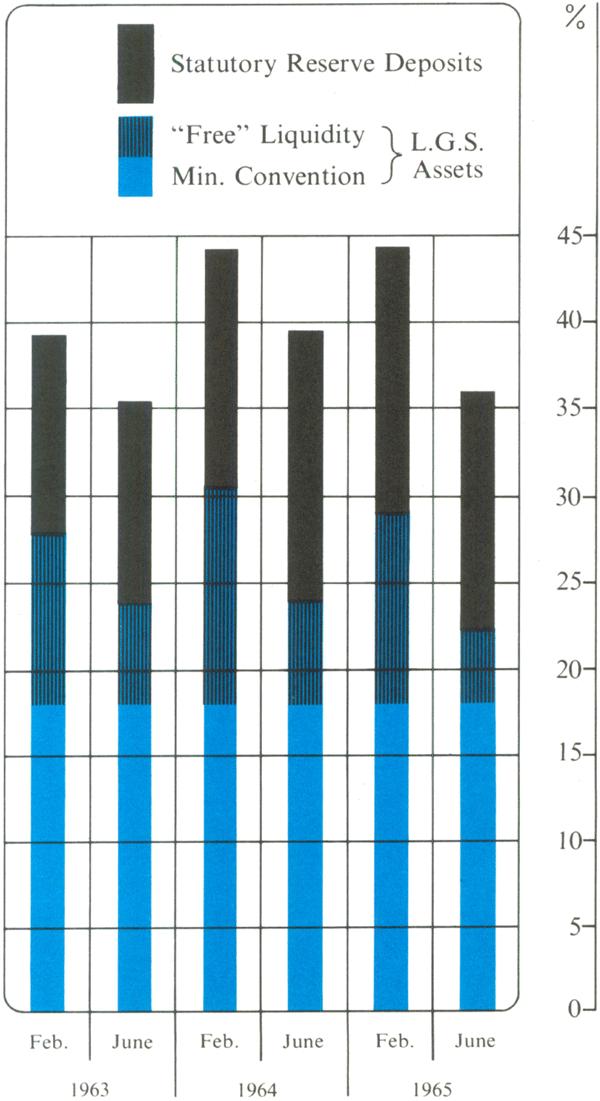
Bank lending
Bank lending policy in 1964/65 was directed towards limiting the growth in expenditure. It was clear the pressures on the banks would be very great indeed and if all demands were met the effects on private liquidity and expenditure generally could endanger the continuance of steady growth and high employment.
In September, the Reserve Bank asked the trading banks to effect some reduction in their new lending; to avoid, as far as practicable, further increases in overdraft limits outstanding; and to keep the movement in outstanding advances within reasonable bounds. The outcome as reflected in these statistics and in other ways was kept under constant review and discussed with the banks from time to time as the year progressed.
The banks continued to exercise restraint in their new lending but they came under increasing pressure as the full effect of the fall in liquidity spread through the community. Over the year, the rate of new overdraft approvals averaged around £10 million a week, much the same as in the previous two years.
Bank lending in 1964/65 was affected by some special factors. As a consequence of the industrial dispute at Mount Isa, the banking system was called upon to finance large copper imports. Drought conditions in some States also led to demands on the banks over the closing months of the year but during 1964/65 lending for drought purposes did not become a very significant part of total bank lending. However, it appeared that the need for finance would increase, particularly when the drought broke and restocking commenced. Accordingly, the Bank decided in June that banks should be informed that in providing necessary bank finance for purposes arising from the drought, additional lending might be undertaken outside the general limitation on new lending commitments.
Banks supplemented the restraint they were exercising on new approvals by action to achieve high rates of cancellations and reductions. The very different conditions from the previous year were reflected mainly, however, in a much larger increase in advances outstanding. In 1963/64 outstanding overdraft limits increased by £79 million but advances by only £14 million, the ratio of total advances to total limits falling from 57 to 55 per cent. In 1964/65 limits increased by £64 million and advances by £123 million, raising the utilization ratio to 60 per cent, the highest June figure since 1961. (All figures exclude temporary finance for wool-buyers and term loans.)
Major Trading Banks Overdraft Lending
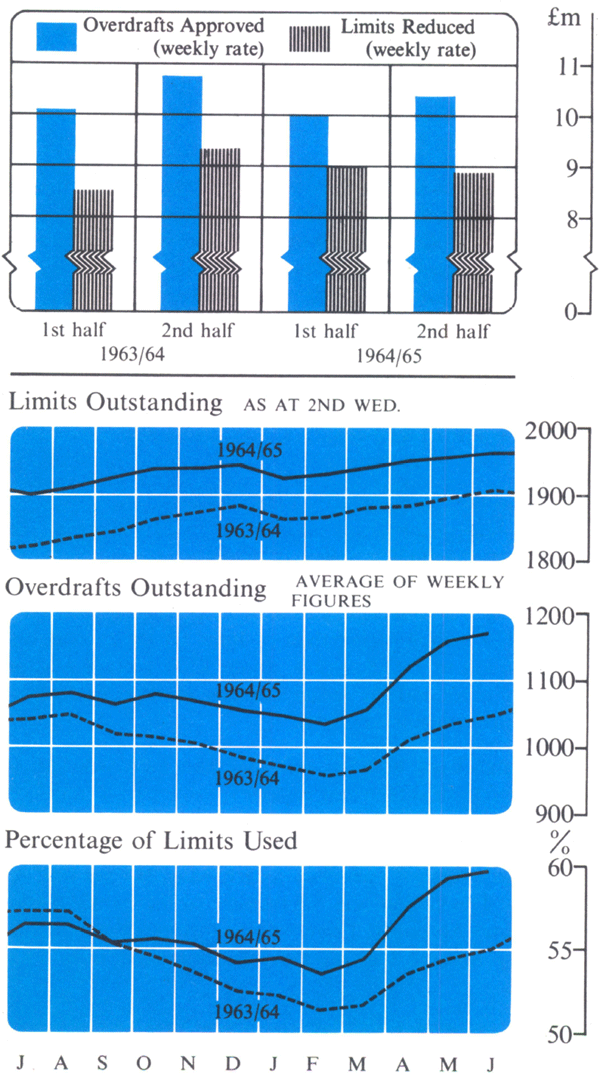
Term lending
Term lending has continued to play a useful role. New loans of £38 million were approved in 1964/65, and outstandings increased by £28 million. Nearly one-half of all term lending has been for manufacturing and one-third for rural purposes.
To enable lending to continue at this rate further transfers were made to the trading banks' Term Loan Fund Accounts with the Reserve Bank. As already mentioned, a transfer from Statutory Reserve Deposit Accounts was made in July, 1964 to complete an increase in Term Loan Funds equal to 1 per cent of deposits as announced in February. Later in 1964/65, it was decided that these Funds would be increased further by an amount equal to 0.6 per cent of deposits; 0.4 per cent was transferred from Statutory Reserve Deposit Accounts in May and 0.2 per cent was to be transferred by banks from resources in their own hands before the end of September, 1965. Now that term lending has been running for some years, repayments are becoming an important source of funds for new lending.
At June, 1965 total term loans outstanding amounted to £86 million and the balances remaining in Term Loan Fund Accounts with the Reserve Bank were £22 million. Some part of this amount, of course, had been committed but not yet drawn.
Export finance
As foreshadowed in the last Report, the Australian Banks' Export Re-Finance Corporation Limited was established during the year, commencing business on 1st September. The Corporation was designed to provide assistance to individual banks to enable them to handle very large or extended export transactions without undue strain on their own resources. So far the amount and distribution of export transactions has been such that the banks have been able to finance them without resort to the Corporation.
Interest rates
Trading bank deposit and lending rates had been raised in April, 1964, as an encouragement to savings and a discouragement to excess spending and rising asset values. In September, the maximum period for which fixed deposits could be accepted by trading banks was extended from 15 to 24 months. The previous rate of 4 per cent for deposits from 12 to 15 months was extended to deposits of 12 to 18 months, and the rate on deposits over 18 and up to 24 months was fixed at 4¼ per cent.
In March, 1965, with continuing pressure on domestic resources and a heavy deficit emerging on external account, the general level of rates was raised. Deposit rates for periods up to 18 months were increased by ½ per cent and rates for the longest period by¼ per cent. At the same time, the maximum overdraft rate was raised by ¼ per cent to 7¼ per cent. This rate is historically high for Australia but is not high in relation to rates ruling in other sections of the capital market.
The level of interest rates in Australia could have a significant effect on capital inflow. A large and increasing number of companies have the choice between borrowing in Australia or overseas, either directly or through a parent or subsidiary company. There are signs of an increasing interest awareness as companies realise that it can be worthwhile to shift borrowing (and also the short term investment of surplus funds) from one country to another. American companies are also under strong pressure to borrow outside the United States; the present differential in interest rates would appear to be at least a marginal discouragement to their borrowing in Australia.
Savings Banks
Savings bank deposits increased in 1964/65, on the end-June figures, by £207 million or 9 per cent, following a rise of £270 million in 1963/64 and £236 million in 1962/63. The rate of increase fell away sharply from £85 million in the September quarter to £45 million in the December quarter and £24 million in the March quarter. The rise of £53 million in the June quarter was less than the amount of interest added to accounts reflecting, perhaps, the changed rural income position and the relative attractiveness of other forms of investment.
With the smaller growth in deposits in 1964/65 the increase in holdings of Commonwealth Government securities (including Treasury notes) at around £36 million, was £48 million less than in 1963/64. Also, in 1963/64, savings bank deposits with the Reserve Bank had risen by £32 million; in 1964/65 they showed little change. Holdings of local and semi-governmental securities increased slightly more than in the previous year.
The rise of £94 million in housing loans outstanding to individuals and building societies was £8 million smaller than in 1963/64. For all savings banks the ratio of housing loans outstanding to depositors' balances increased from 22 to 24 per cent over the year; the ratio for savings banks subject to the Banking (Savings Banks) Regulations was about 2 per cent lower at both dates.
Total loan approvals for housing in the September quarter were above those recorded a year earlier but the rate fell in subsequent quarters and total approvals for the year were about 4 per cent lower than in 1963/64. There was some increase in lending for flats within this total, but savings bank activity in this field is still small.
In the aggregate, the level of lending for housing by savings banks appeared adequate during the year in relation to the capacity of the industry and the pressures on its resources. In its consultations with the savings banks, the Reserve Bank sought to ensure that their lending for housing remained consistent with the longer term growth in their deposits.
An increase of ¼ per cent in interest rates on savings bank deposits took effect in the June quarter. Following this increase most savings banks raised their rates for housing loans by the same amount.
Savings Banks
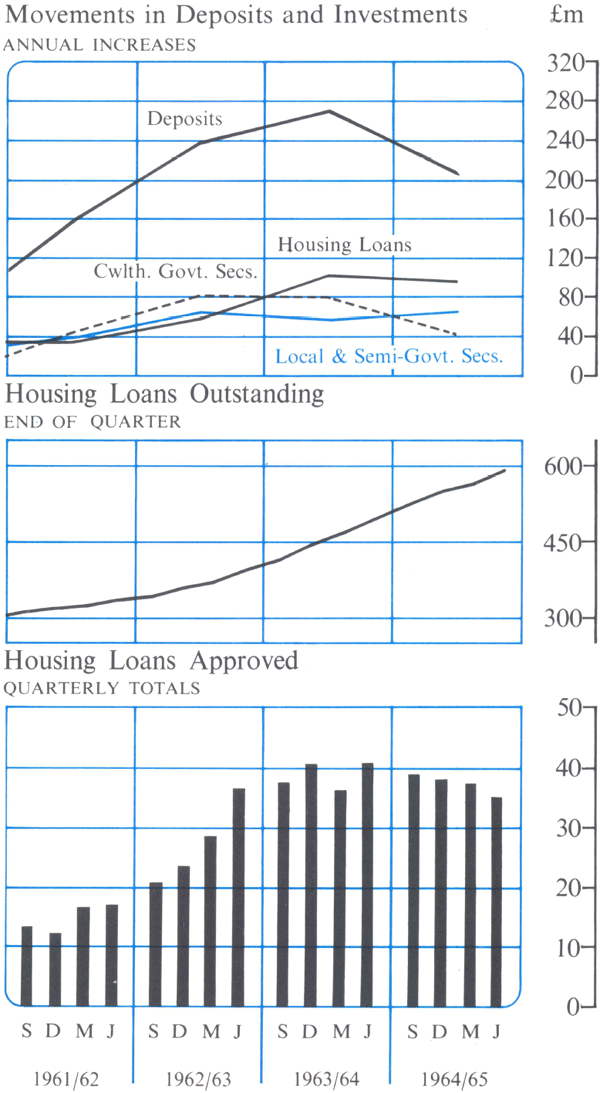
Government Securities Market
Consistent with broad monetary policy, the general trend of market yields on Commonwealth bonds throughout 1964/65 was upward. The movement was in two distinct stages, separated by some months of steady yields.
Security yields rose in July, more markedly on longer dated stocks, completing a movement in the whole structure of yields begun in April, 1964. With a well subscribed August cash and conversion loan, the market steadied and generally yields settled at about existing levels until February. At the close of 1964 and early in 1965, with prospects for tighter liquidity conditions later in the year, expectations of rising yields developed among some investors and the February loan was substantially under-subscribed. Market yields rose sharply on short dated stocks late in February and on all stocks during March. There were increases in bank overdraft and fixed deposit rates in March and the rates offered in the April loan (and on a new series of Special Bonds) were in line with the higher rates then prevailing on the market. Yields again steadied, and the year finished with yields on short and medium dated stocks more than ⅝ per cent higher than a year earlier, and yields on long dated stocks about ½ per cent higher.
Until well into the third quarter the Bank was a substantial net seller of securities but with the heavy run-down in liquidity particularly affecting the banking system, the Bank accepted the need to buy large parcels of securities during the last quarter. Over the whole year the Bank was a net purchaser of securities as the result of its trading. In addition, to strengthen and provide greater balance in its portfolio, the Bank acquired £50 million of Commonwealth Government securities in exchange for Treasury bills in a funding operation with the Commonwealth. The result was that at 30th June, 1965, the Bank's portfolio of Commonwealth Government securities (other than Treasury bills) was £97 million larger than a year earlier. In 1963/64 it had fallen £23 million.
Yields on Commonwealth Government Securities*
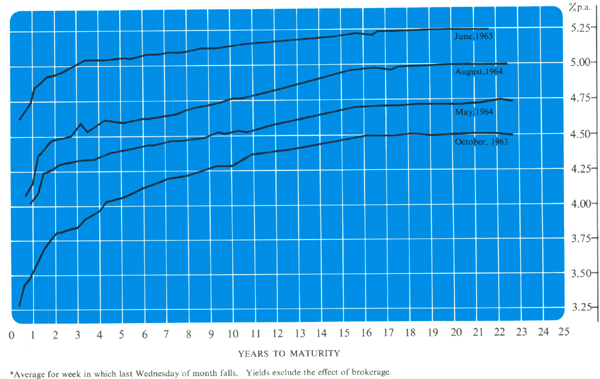
The yield on Treasury notes was raised by ½ per cent over the year to a final level of 4¼ per cent, by successive reductions in the issue price in August, January and April.
The maximum public issue rate for semi-governmental securities moved in sympathy with the Commonwealth long term bond rate, rising from just under 5 per cent at the beginning of the year to 5¼ per cent in August and 5½ per cent in March. As in the previous year, investors in public issues were given the option of medium or long term securities at different interest rates. For most of the year, market yields on existing semi-governmental issues were generally about ¼ per cent above the maximum rate offered on new public issues. The maximum rate approved for long term private loans at the end of the year was 5¾ per cent, ⅝ per cent above the rate at the beginning of the year.
Short Term Money Market
With rising interest rates and tightening liquidity, 1964/65 was not an easy year for dealers in the short term money market.
This was the first full year in which dealers were not subject to precise limits imposed by the Bank on the total amount of loans accepted. The level of loans held by dealers fluctuated, at times sharply, during the year between £120 million and the former market limit of £180 million. In these circumstances, there was increased competition for funds and recourse to the Bank for last resort assistance was more frequent, for larger amounts and for longer periods than in previous years.
For most of the year, the general level of interest rates paid by dealers showed little movement from month to month, but with the tightness of money in the last quarter rates rose rapidly to an average level of around 4¼ per cent, some ¾ per cent higher than earlier in the year.
From 22nd March, 1965, short term money market dealers were permitted to deal in commercial bills accepted or endorsed by a trading bank, and to hold a proportion of their portfolios in bills of this type. Activity in bills in the first few months was quite small; at 30th June, dealers held about £5 million of this paper in their portfolios.
During the year there was a procedural change in the safe custody system for dealers' holdings of Commonwealth Government securities. Whereas previously the Bank had issued safe custody receipts in the names of individual lenders, it now issues bearer safe custody certificates which circulate in the market generally, thus removing the need to prepare a new safe custody document for each of the many loans accepted by dealers.
Commercial Bills Market
During the year the Bank, at the request of the Commonwealth Government, carried out an examination into the best conditions for the development of a sound and effective market in commercial bills. Leading from this investigation it was agreed that banks would undertake additional commercial bill activity in order to test and explore the real demand for this form of financing. In addition, dealers in the short term money market with whom the Bank has last resort arrangements, were for the first time permitted, subject to the restrictions noted above, to trade in and hold commercial bills.
There has been a small development of commercial bill business outside the arrangements outlined above. The Bank has kept itself informed of such activities and has maintained touch with organisations carrying out the function of accepting or discounting commercial bills.
It has been suggested to these concerns that wherever there is any doubt whether a non-bank financial institution may be carrying on business of the character of banking business it should seek an exemption under section 11 of the Banking Act. Section 11 exemptions, of which a large number have been granted, may be with or without conditions and normally exempt the applicant from section 8, requiring an authority to carry on banking business.